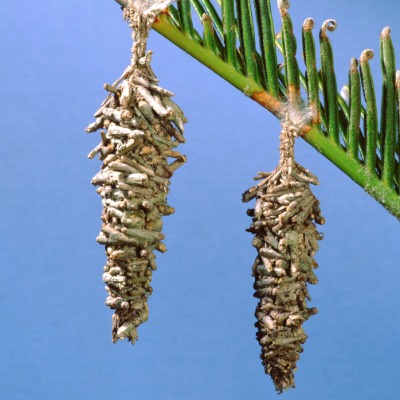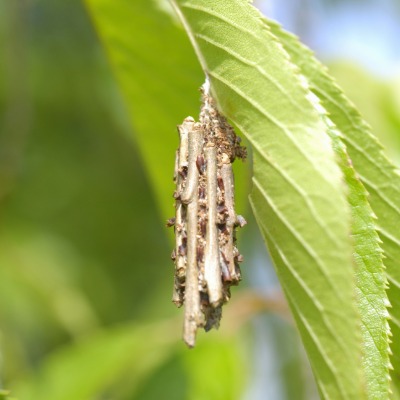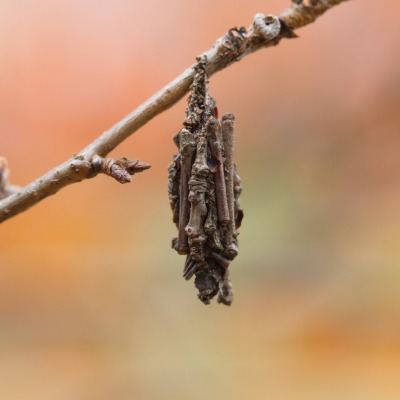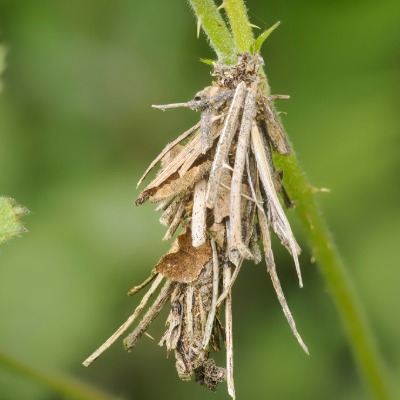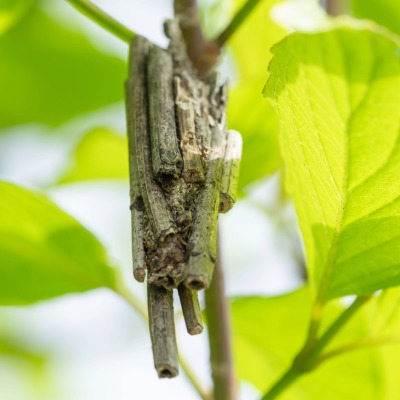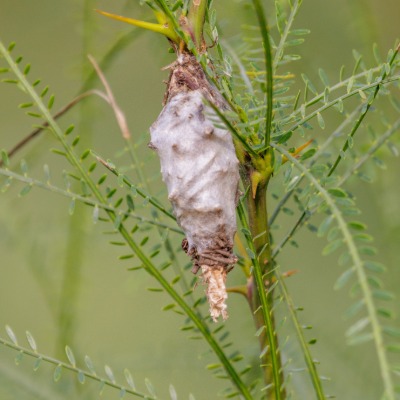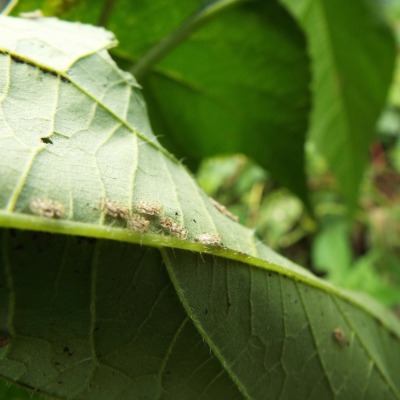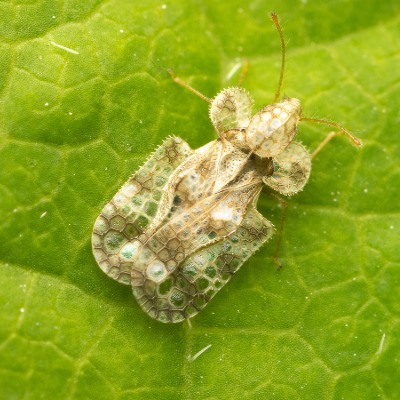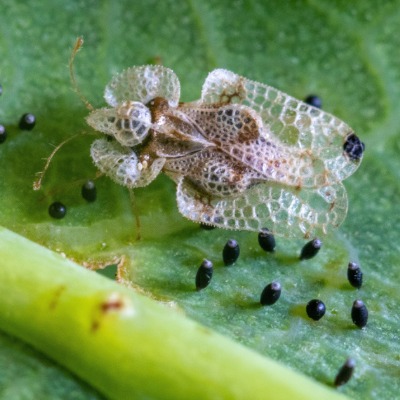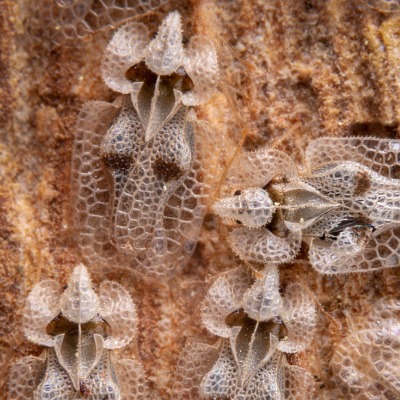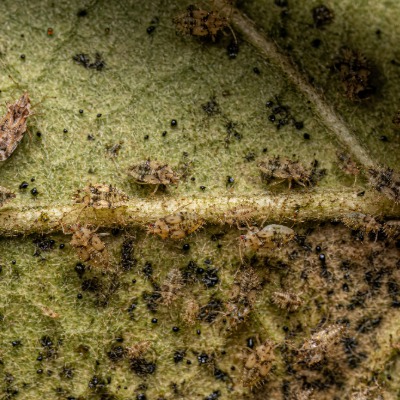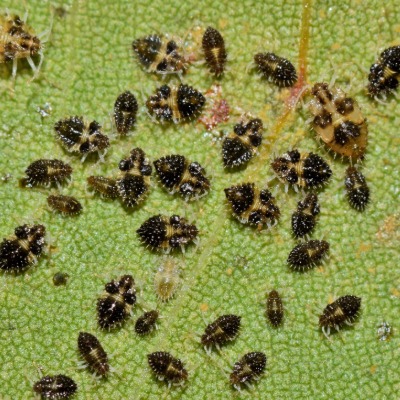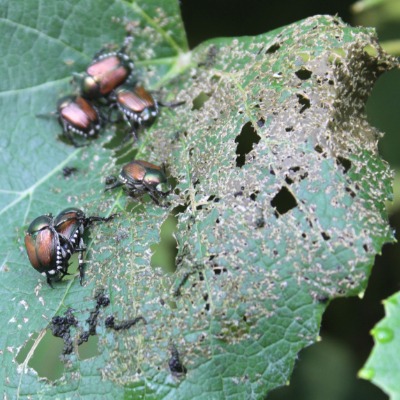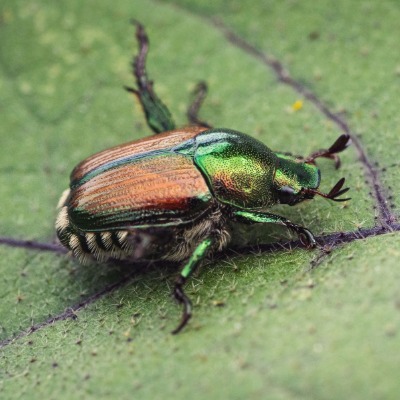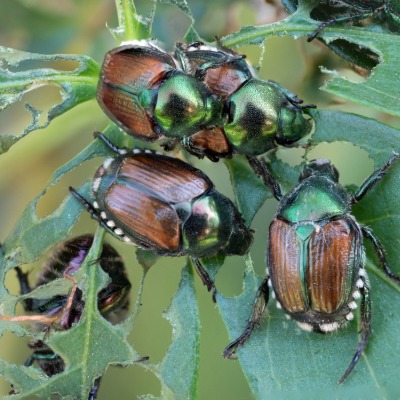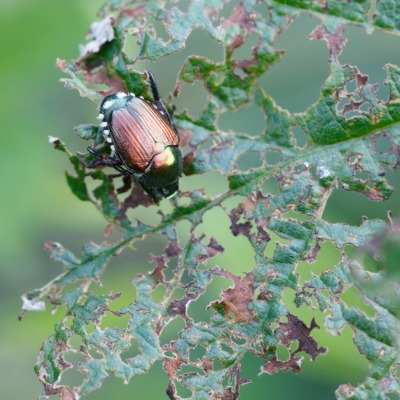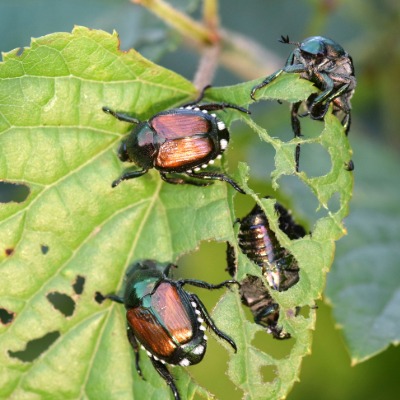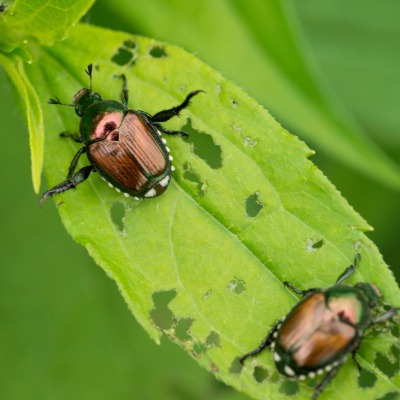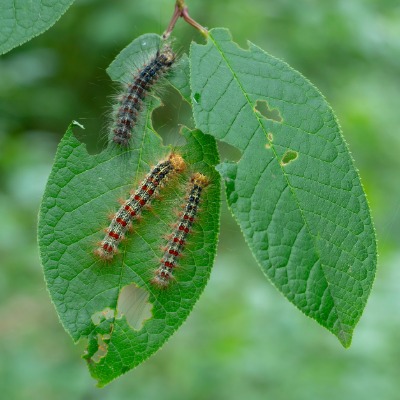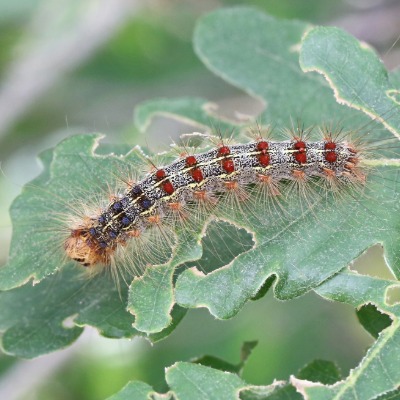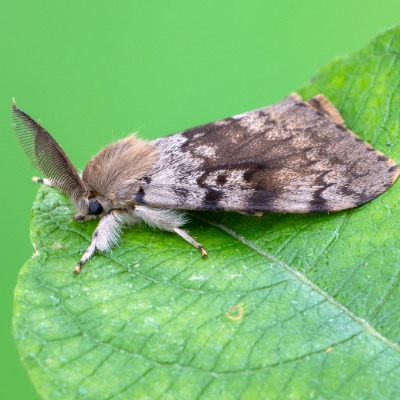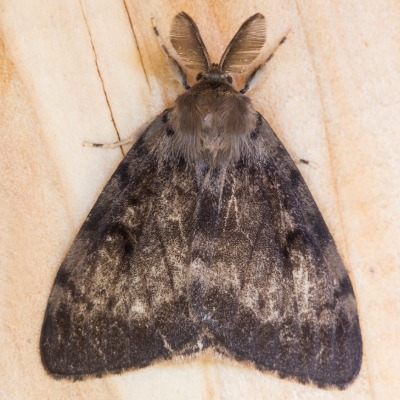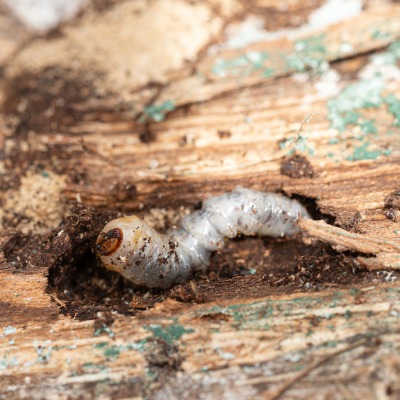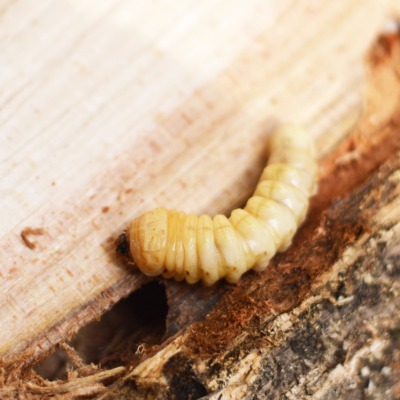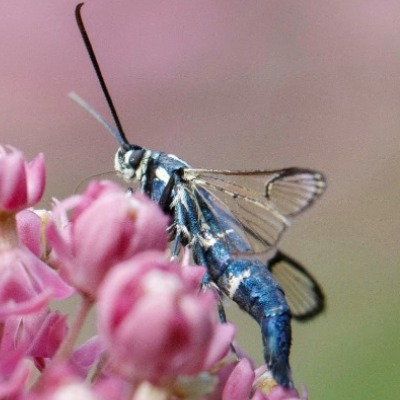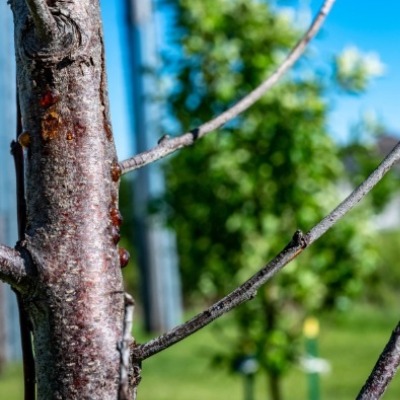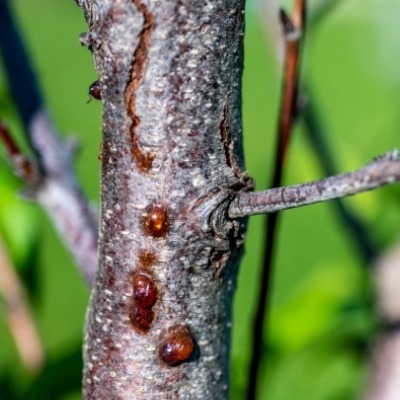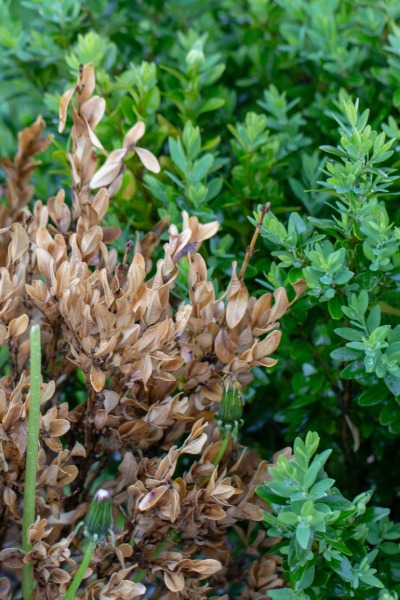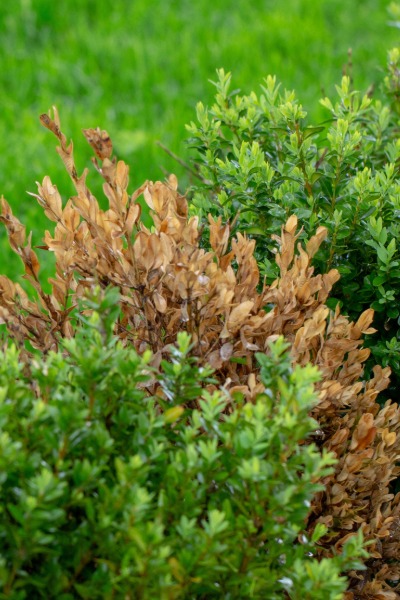NATURAL METHODS FOR PEST CONTROL
COMMERCIAL LANDSCAPE MANAGEMENT - SERVICING MARYLAND, DC, AND VIRGINIA
Regularly inspect your plants for signs of insect infestations and take appropriate measures to control and manage these pests to prevent damage to your plants. Common plant pests include insects, diseases, and weeds that compromise the health and growth of plants, requiring various control methods such as removal, water jets, and the planting of deterrent plants.
COMMON INSECT PESTS
Insect pests are a significant threat to plants, feeding on their sap, stunting growth, and transmitting diseases. Effective management of these common insect pests often involves a combination of preventive measures, such as maintaining healthy plants and using companion planting, alongside control methods like insecticidal soaps or introducing natural predators. Understanding the life cycles and behaviors of these pests is crucial for timely intervention and protecting plant health.
These small, soft-bodied insects feed on plant sap on leaves, stems, and roots and can cause stunted growth and distorted leaves. Adults are typically 1/16 inch long and can be transparent, yellow, green, or brown. Eggs are small and are yellowish in color. Larvae are orange or yellowish, with a rounded body that tapers toward the head. Adults usually emerge in spring to early summer and can live up to one month.
DAMAGE LEVELS
High - Transmits Viruses
NESTS
Underside of Leaves
INFESTATION PERIOD
Spring - Early Summer
PESTICIDES
Diatomaceous Earth / Neem Oil
DETERRENTS
Lavender / Nasturtium
PREDATORS
Lacewings / Lady Bugs
These tiny, moth-like insects can cause yellowing, wilting, and reduced vigor in plants by feeding on their sap. Adults are typically 2mm long, with white wings and a wing span of 3mm. Eggs are elongated and laid in a spiral. Larvae have the shape of a flattened ellipse with waxy bristles. Adults usually emerge in the summer and can live up to 40 days.
DAMAGE LEVELS
High - Transmits Viruses
NESTS
Underside of Leaves
INFESTATION PERIOD
Summer
PESTICIDES
Diatomaceous Earth / Neem Oil / Sticky Traps
DETERRENTS
Bee Balm / Nasturtium
PREDATORS
Parasitoid Wasps / Lady Bugs
These tiny arachnids feed on plant sap and can cause stippling, discoloration, and webbing on the leaves. Adults are less 1mm long, and spin protective spin webs. Eggs are transparent spherical eggs. Adults usually emerge in summer and can live up to 2 weeks to a month.
DAMAGE LEVELS
High - Transmits Viruses
NESTS
Leaf Veins
INFESTATION PERIOD
Summer - Autumn
PESTICIDES
Diatomaceous Earth / Neem Oil
DETERRENTS
Chrysanthemum / Nasturtium
PREDATORS
Spider Mite Destroyer Beetle
These insects resemble fish scales or mussels and can be found on stems and leaves, where they feed on plant sap and can cause yellowing, wilting, and leaf drop. Adults are less than 1-2mm long and covered in scaly wax. Females are elliptical or circular in shape with a protective scale-like hard or soft armor, and males have visible wings and legs. Eggs are transparent and elongated. Adults usually emerge in the summer and can live for up to 2 months.
DAMAGE LEVELS
Medium - Transmits Fungi
NESTS
Underside of leaves
INFESTATION PERIOD
Summer
PESTICIDES
Diatomaceous Earth / Neem Oil
DETERRENTS
Catnip / Nasturtium
PREDATORS
Scale Eating Beetle / Armored Scale Predator
Bagworms are moth caterpillars that create protective bags out of silk and plant material that they attach to themselves, making them resemble small twigs or leaves. The damage they inflict is often visible during late summer, when their larvae's feeding leads to defoliation of shrubs. Eggs are typically laid within these protective bags, and when they hatch, the larvae emerge to start feeding, measuring up to 2 inches, and go to the pupal stage in 2-3 weeks.
DAMAGE LEVELS
Medium - Transmits Viruses
NESTS
Protective Bag
INFESTATION PERIOD
Summer
PESTICIDES
Diatomaceous Earth / Neem Oil
DETERRENTS
Marigold / Nasturtium
PREDATORS
Praying Mantis / Ladybugs
Thrips are very small, slender insects that feed on plant tissues, causing stippling, discoloration, and distorted growth. Adults are 1/2 to 4mm long with both winged and wingless forms. Eggs are very small and are inserted into a slit in the plant surface. Adults usually emerge in midsummer and can live up to 1 and a half months.
DAMAGE LEVELS
Medium - Transmits Fungi
NESTS
Underside of leaves
INFESTATION PERIOD
Midsummer
PESTICIDES
Diatomaceous Earth / Neem Oil
DETERRENTS
Lavender / Nasturtium
PREDATORS
Swirski / Thripex
Lace bugs are known by their delicate, lace-like wings and their small size, making them difficult to spot until they have caused noticeable damage. They inflict damage by feeding on the sap of plants, leading to stippling, yellowing, and leaf drop. Eggs are tiny, translucent, or pale green spheres found on the underside of leaves. Adults emerge in late spring or early summer, measuring about 1/8 inch in length, and live up to 1 and a half months.
DAMAGE LEVELS
High - Transmits Viruses
NESTS
Underside of leaves
INFESTATION PERIOD
Summer
PESTICIDES
Diatomaceous Earth / Neem Oil
DETERRENTS
Lavender / Nasturtium
PREDATORS
Ladybugs / Lacewings
These small, soft-bodied insects, often covered with a white powdery substance, can be found on stems and leaves, where they feed on plant sap and excrete honeydew, leading to sooty mold growth. Adults are 1 to 5mm long, with females in the permanent nymph stage with feet to move about and males with wasp-like appearance and wings. Eggs are laid in the same waxy deposit used for protection by the female. Adults usually emerge in midsummer and can live up to 2 months.
DAMAGE LEVELS
High - Transmits Viruses
NESTS
Underside of leaves
INFESTATION PERIOD
Midsummer
PESTICIDES
Diatomaceous Earth / Neem Oil
DETERRENTS
Lavender / Lemongrass
PREDATORS
Mealybug Destroyer / Minute Pirate Bugs
Japanese beetles have a distinctive metallic green body and bronze-colored wings. They emerge in late spring to early summer and begin to feed voraciously on foliage, flowers, fruits, even shrubs and grasses. The damage results in skeletonizing of leaves, where only the veins remain, leading to weakened plants. Females lay eggs in the soil, usually in late June to early July. They hatch into grubs that feed on the roots of grass and other plants and grow up to ½ inches long adult beetles that live for up to a month and a half.
DAMAGE LEVELS
High - Damages foliage
NEST
Underground
INFESTATION PERIOD
Early Summer
PESTICIDES
Bt insecticide / Neem Oil
DETERRENTS
Catnip / Marigold
PREDATORS
Birds / Spiders
Gypsy Moth larvae are hairy and can vary in color from greenish-yellow to brown. As they grow, they develop a series of red spots along their sides, which can help in identification. Larvae can reach lengths of up to 2.5 inches, seen in late spring and early summer when they actively feed on the leaves of various trees and shrubs. Eggs are laid on the bark of trees, and once they hatch, the larvae enter a prolonged larval stage that can last several weeks, voraciously consuming leaves, leading to defoliation of the affected plants.
DAMAGE LEVELS
High - Damages foliage
NEST
Tree Bark
INFESTATION PERIOD
Early Summer
PESTICIDES
Bt insecticide / Neem Oil
DETERRENTS
Anise / Lavender
PREDATORS
Lacewing / Praying Mantis
The larvae of this bright metallic-green beetle bore into the Ash tree and feed under the bark, which disrupts the tree's ability to transport water and nutrients, resulting in dieback and bark splitting. Adults are typically ½ inch long and 1/8 inch wide. Eggs are extremely small and reddish-brown in color. Larvae are white, flat-headed borers with a distinct segmentation. Adults emerge in midsummer and can live for up to 2 years.
DAMAGE LEVELS
High - Burrows Ash Trees
HOST TREE
Ash Trees
INFESTATION PERIOD
Midsummer
PESTICIDES
Soil Applied / Trunk Injected
DETERRENTS
Sticky Band Traps / Pan Traps
PREDATORS
Parasitic Wasps
The peachtree borer primarily targets peach and other stone fruit trees. Eggs are laid on the base of the tree and hatch in 10 days into larvae that overwinter until spring, burrowing into the wood, feeding on inner tissues, and causing extensive damage to the tree's vascular system. Signs of infestation are the presence of tree sap, which can ooze from the wounds created by the larvae. This tunneling leads to wilting and stunted growth. It grows into a moth with a wingspan of 1.5 inches, with dark, brownish-gray wings is somewhat difficult to spot against the bark of trees.
DAMAGE LEVELS
High - Burrows Peach Trees
HOST TREE
Peach / Stone Fruit Trees
INFESTATION PERIOD
Spring
PESTICIDES
Soil Applied / Trunk Injected
DETERRENTS
Sticky Band Traps / Pan Traps
PREDATORS
Parasitic Wasps
common BENEFICIAL INSECTS
One of the best natural insect control methods is to introduce beneficial insects and predators that prey specifically on common plant pests. Before releasing beneficial insects, determine the kind of insect pest infesting your plants to ensure that they will have nourishment and stay in your landscape. Beneficial insects can be purchased from online sources and local nurseries.
Convergent ladybugs have two white lines on the top of their head that slant towards each other, as if they're converging. Keep in a cool place until ready to release. Place the ladybug container near plants with heavy populations of pest insects (aphids, mealybugs) on which the ladybugs will feed and lay eggs. Spritz the surrounding vegetation with a mist of water so they can hydrate while acclimating. Consider placing a piece of cardboard with a few drops of honey on it near the container while leaving it overnight as a quick energy source
TARGET PESTS
Aphids
Mealy Bugs
Scales
Thrips
RELEASE TIME
Early morning
Late afternoon
Twice-stabbed ladybugs, also known as "Scale Eating Beetle," are shiny black and have two red spots on each side. Keep in a cool place until ready to release. Place the ladybug container near plants with heavy populations of pest insects (aphids, mealybugs) on which the ladybugs will feed and lay eggs. Spritz the surrounding vegetation with a mist of water so they can hydrate while acclimating. Consider placing a piece of cardboard with a few drops of honey on it near the container while leaving it overnight as a quick energy source.
TARGET PESTS
Hard Armored Scales
Soft Armored Scales
RELEASE TIME
Early morning
Late afternoon
The mealybug destroyer ladybug is a shiny black ladybug adorned with two distinctive red spots, recognized for its role in controlling mealybug populations. Keep in a cool place until ready to release. Place the ladybug container near plants with heavy populations of pest insects (aphids, mealybugs) on which the ladybugs will feed and lay eggs. Spritz the surrounding vegetation with a mist of water so they can hydrate while acclimating. Consider placing a piece of cardboard with a few drops of honey on it near the container while leaving it overnight as a quick energy source.
TARGET PESTS
Mealybug
RELEASE TIME
Early morning
Late afternoon
Whitefly predatory ladybugs emerge brown and eventually turn shiny black and feed on eggs, larvae and adult whiteflies. Keep in a cool place until ready to release. Place the ladybug container near plants with heavy populations of pest insects (whiteflies) on which the ladybugs will feed and lay eggs. Spritz the surrounding vegetation with a mist of water so they can hydrate while acclimating. Consider placing a piece of cardboard with a few drops of honey on it near the container while leaving it overnight as a quick energy source.
TARGET PESTS
Whiteflies
RELEASE TIME
Early morning
Late afternoon
Spidermite destroyer ladybugs are black with tiny hairs and prey on spidermites as larvae and adults. Keep in a cool place until ready to release. Place the ladybug container near plants with heavy populations of pest insects (spidermites) on which the ladybugs will feed and lay eggs. Spritz the surrounding vegetation with a mist of water so they can hydrate while acclimating. Consider placing a piece of cardboard with a few drops of honey on it near the container while leaving it overnight as a quick energy source. Ladybugs also feed on harmful honeydew left by feeding pest insects and fungi.
TARGET PESTS
Spidermites
Aphids
RELEASE TIME
Early morning
Late afternoon
Known for their striking green color and intricate, lace-like wings, their larvae are voracious predators. Buy lacewing eggs, larvae, or adults from a reputable supplier. Choose a cool time of day to release the lacewings when pest populations are present in the garden. Gently sprinkle the lacewing eggs or larvae onto the affected plants or areas where pests are present. Avoid using chemical pesticides that could harm the lacewings and their larvae. Adult lacewings are attracted to outdoor and garden lights at night.
TARGET PESTS
Aphids
Mealy Bugs
Caterpillars
Spider Mites
RELEASE TIME
Early morning
Late afternoon
A praying mantis is known for its distinctive folded forearms and upright posture. It feeds on a variety of garden pests such as aphids, moths, and caterpillars, helping naturally control pest populations. Select a suitable location during the cooler parts of the day, ideally in the morning or late afternoon. Gently place the mantises or their egg cases on plants where pest activity is observed. Make sure the garden environment provides ample foliage and insects to support their survival. Avoid using chemical pesticides, as these can harm praying mantises and reduce their predatory effectiveness.
TARGET PESTS
Aphids
Mealy Bugs
Caterpillars
RELEASE TIME
Early morning
Late afternoon
COMMON PLANT AND TREE DISEASES
Plant and tree diseases can significantly affect the health and vitality of gardens and lawns, leading to stunted growth. It’s essential to identify the specific issues affecting the plants, such as fungal infections, bacterial infections, or viral illnesses. Once identified, affected plant parts should be promptly removed and disposed of to prevent the spread of disease. This may involve pruning infected leaves or stems or, in severe infestations, removing the entire plant from the garden. Maintaining proper care practices such as watering, fertilizing, and ensuring good air circulation can help prevent the occurrence of plant diseases, promoting a healthier lawn and garden.
This fungal disease appears as a white, powdery coating on the leaves and stems of plants. It thrives in warm, dry conditions. Powdery mildew is a fungal disease characterized by white, powdery spots that appear on the leaves, stems, and buds of affected plants. This unsightly growth can lead to a range of problems for the host plant, including reduced photosynthesis, stunted growth, and compromised overall vigor. As the infection progresses, leaves may yellow, curl, and eventually drop, weakening the plant and making it more susceptible to other pests and diseases.
FUNGICIDES
Apply at the first sign of powdery mildew, in early spring or when conditions become conducive for its development, such as warm, dry weather with high humidity.
MANUAL REMOVAL
Gently wipe affected leaves with a damp cloth or sponge to minimize spore spread.
CHEMICAL REMOVAL
Evenly spray the affected plants, thoroughly covering the upper and lower leaf surfaces using the recommended dosage and frequency.
LAWN PRACTICES
Space plants properly to keep proper air circulation and water plants at the base to keep foliage dry.
Early blight, caused primarily by the fungal pathogens Alternaria solani and Alternaria alternata, manifests as dark, concentric lesions on the leaves of many ornamental and edible plants. These lesions typically begin at the lower leaves and progress upward, leading to leaf drop and reduced photosynthetic capacity. As the disease advances, the overall vigor of the plant diminishes, resulting in stunted growth.
FUNGICIDES
Apply at the first sign of early blight, in early spring or when conditions become conducive for its development, such as warm, dry weather with high humidity.
MANUAL REMOVAL
Remove and destroy infected plant debris at the end of the growing season.
CHEMICAL REMOVAL
Evenly spray the affected plants, thoroughly covering the upper and lower leaf surfaces using the recommended dosage and frequency.
LAWN PRACTICES
Space plants properly to keep proper air circulation and water plants at the base to keep foliage dry.
Boxwood blight is a fungal infection caused by Calonectria pseudonaviculata, a fungus that can affect all aboveground parts of the shrub. Symptoms start as dark spots on the leaves that merge into brown patches. The undersides of affected leaves will display white sporulation of the boxwood blight fungus after periods of high humidity. Boxwood blight leads to quick defoliation, typically beginning on the lower branches and progressing upward.
FUNGICIDES
Apply at the first sign of boxwood blight, in early spring or when conditions become conducive for its development, such as warm, dry weather with high humidity.
MANUAL REMOVAL
Prune infected plant branches and properly dispose of infected material.
CHEMICAL REMOVAL
Evenly spray the affected plants, thoroughly covering the upper and lower leaf surfaces using the recommended dosage and frequency.
LAWN PRACTICES
Space plants properly to keep proper air circulation and water plants at the base to keep foliage dry.
Leaf spot damage to plants is a common plant disease caused by various pathogens, including fungi, bacteria, and viruses. This condition manifests as distinct, discolored spots on the leaves, which can range in color from brown and black to yellow and red, depending on the specific organism responsible for the infection. As the disease progresses, the leaf tissue may die off, leading to leaf drop and reduced photosynthetic capacity, ultimately affecting the overall health and vigor of the plant.
FUNGICIDES
Apply at the first sign of leaf spots, in early summer or when conditions become conducive for its development, such as warm, dry weather with high humidity.
MANUAL REMOVAL
Remove and destroy infected plant debris at the end of the growing season.
CHEMICAL REMOVAL
Evenly spray the affected plants, thoroughly covering the upper and lower leaf surfaces using the recommended dosage and frequency.
LAWN PRACTICES
Space plants properly to keep proper air circulation and water plants at the base to keep foliage dry.
Rust disease is characterized by the appearance of reddish-brown pustules on leaves, stems, and sometimes fruits. These fungal infections disrupt photosynthesis and nutrient uptake, weakening the plants over time. As the disease progresses, it can cause leaf drop, stunted growth, and reduced vigor. Effective management strategies, including the use of resistant varieties, crop rotation, and timely fungicide applications, are crucial to mitigating the impact of rust diseases and ensuring sustainable agricultural production.
FUNGICIDES
Apply at the first sign of rust disease, in early spring or when conditions become conducive for its development, such as warm, dry weather with high humidity.
MANUAL REMOVAL
Remove and destroy infected plant debris at the end of the growing season.
CHEMICAL REMOVAL
Evenly spray the affected plants, thoroughly covering the upper and lower leaf surfaces using the recommended dosage and frequency.
LAWN PRACTICES
Space plants properly to keep proper air circulation and water plants at the base to keep foliage dry.
Root rot can be caused by various pathogens, including Phytophthora and Pythium species. This disease is a significant threat to plant health, caused primarily by various soil-borne pathogens such as fungi and water molds. This condition leads to the gradual decay of a plant's root system, resulting in poor nutrient and water uptake, stunted growth, and ultimately, plant decline or death. Symptoms often include yellowing leaves, wilting, and a lack of vigor, which can be mistaken for other issues such as drought stress or nutrient deficiencies.
FUNGICIDES
Apply at the first sign of root rot, in early summer or when conditions become conducive for its development, such as warm, dry weather with high humidity.
MANUAL REMOVAL
Remove and destroy infected plant debris at the end of the growing season.
CHEMICAL REMOVAL
Remove affected plant from its planting bed or pot then apply the fungicide at the root zone and surrounding soil. Replant or repot the plant in fresh, well-draining soil.
LAWN PRACTICES
Have proper rain drainage in place in planting areas and drain holes in planters to prevent waterlogging.
Gray mold or Botrytis blight, caused by the fungus Botrytis cinerea, can lead to significant damage in a wide variety of plants, and appears as gray mold on flowers, leaves, and stems. The disease typically thrives in humid conditions, where it can rapidly spread, particularly in dense plantings or overcrowded environments. Symptoms include water-soaked spots on leaves that eventually decay, and flowers may become mushy and brown. Infected plants experience weakened structures and reduced photosynthetic capacity, leading to diminished growth.
FUNGICIDES
Apply at the first sign of gray mold, in early summer or when conditions become conducive for its development, such as warm, dry weather with high humidity.
MANUAL REMOVAL
Remove and destroy infected plant debris at the end of the growing season.
CHEMICAL REMOVAL
Evenly spray the affected plants, thoroughly covering the upper and lower leaf surfaces using the recommended dosage and frequency.
LAWN PRACTICES
Space plants properly to keep proper air circulation and water plants at the base to keep foliage dry.
Beech leaf disease is a harmful condition affecting beech trees, characterized by distinctive leaf deformities and premature leaf drop. It can lead to weakened tree health and even death if unmanaged. The disease's effects include dark banding on leaves, dieback of branches, and overall decline in vigor.
FUNGICIDES
Apply at the first sign of the disease, in early summer or when conditions become conducive for its development, such as warm, dry weather with high humidity.
MANUAL REMOVAL
Remove and destroy infected plant debris at the end of the growing season.
CHEMICAL REMOVAL
Evenly spray the affected plants, thoroughly covering the upper and lower leaf surfaces using the recommended dosage and frequency.
LAWN PRACTICES
Space plants properly to keep proper air circulation and water plants at the base to keep foliage dry.
Rose Rosette Disease (RRD) is a serious viral disease affecting roses, characterized by abnormal growth, excessive thorn development, and mottled or distorted leaves. It can severely weaken and ultimately kill affected plants if not managed properly.
COMPLETE REMOVAL
Remove carefully and slowly by digging up and removing entirely from the roots. Do not add to yard waste or compost.
TEST SOIL FOR MITES
Consider testing the soil for presence of mites and viruses before replanting to prevent infestation.
MIX PLANTING ROSES
Consider interplanting roses with other plants to disrupt the disease cycle and place in non-windy area to prevent mite dispersal.
LAWN PRACTICES
Sanitize any pruning or digging tools used in removal of infected roses to avoid mite dispersal.
Ready to discuss your vision?
Let's schedule a consultation!



















